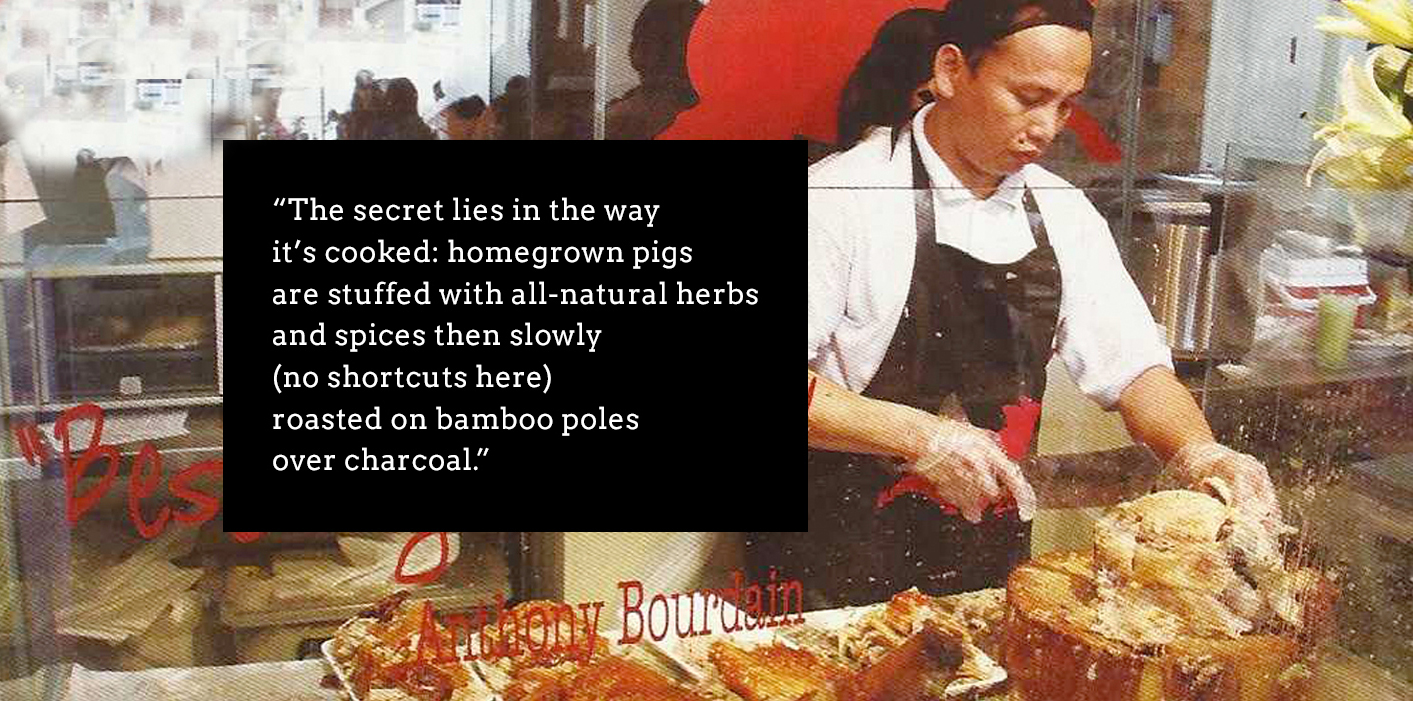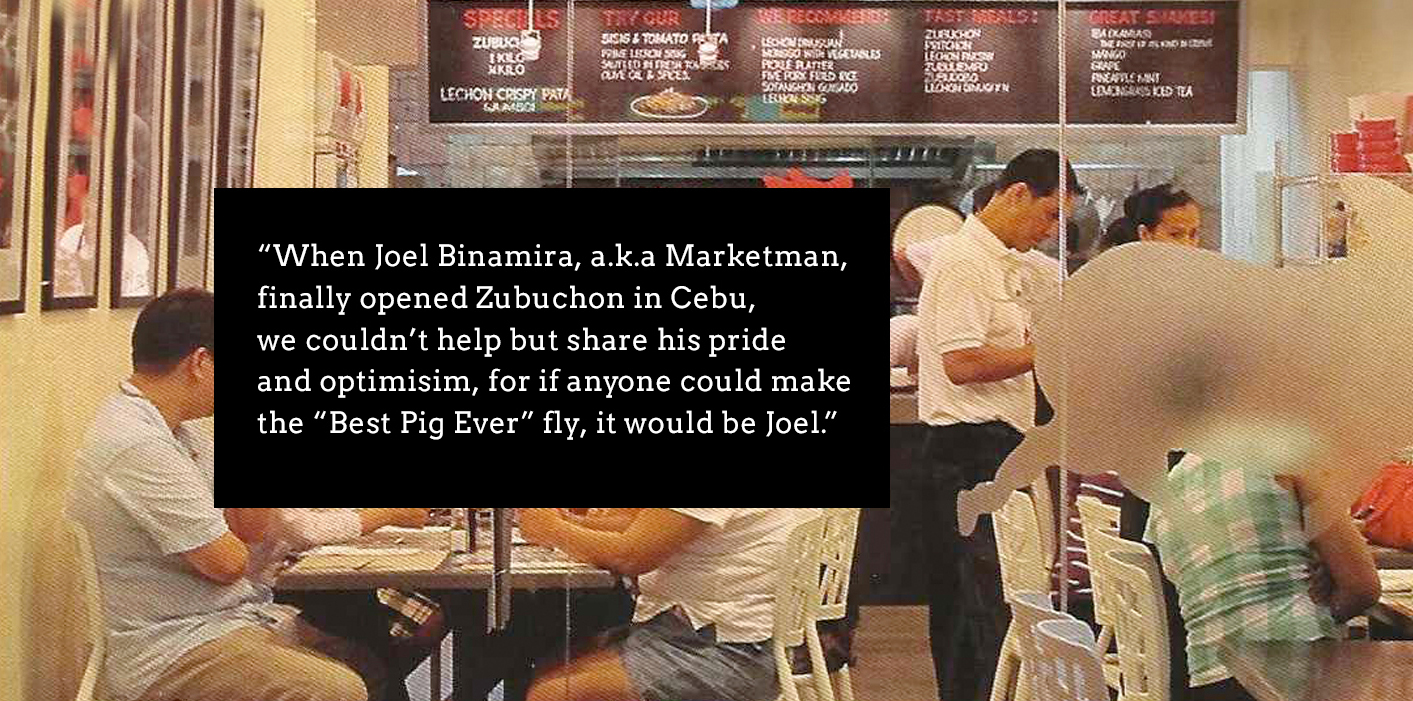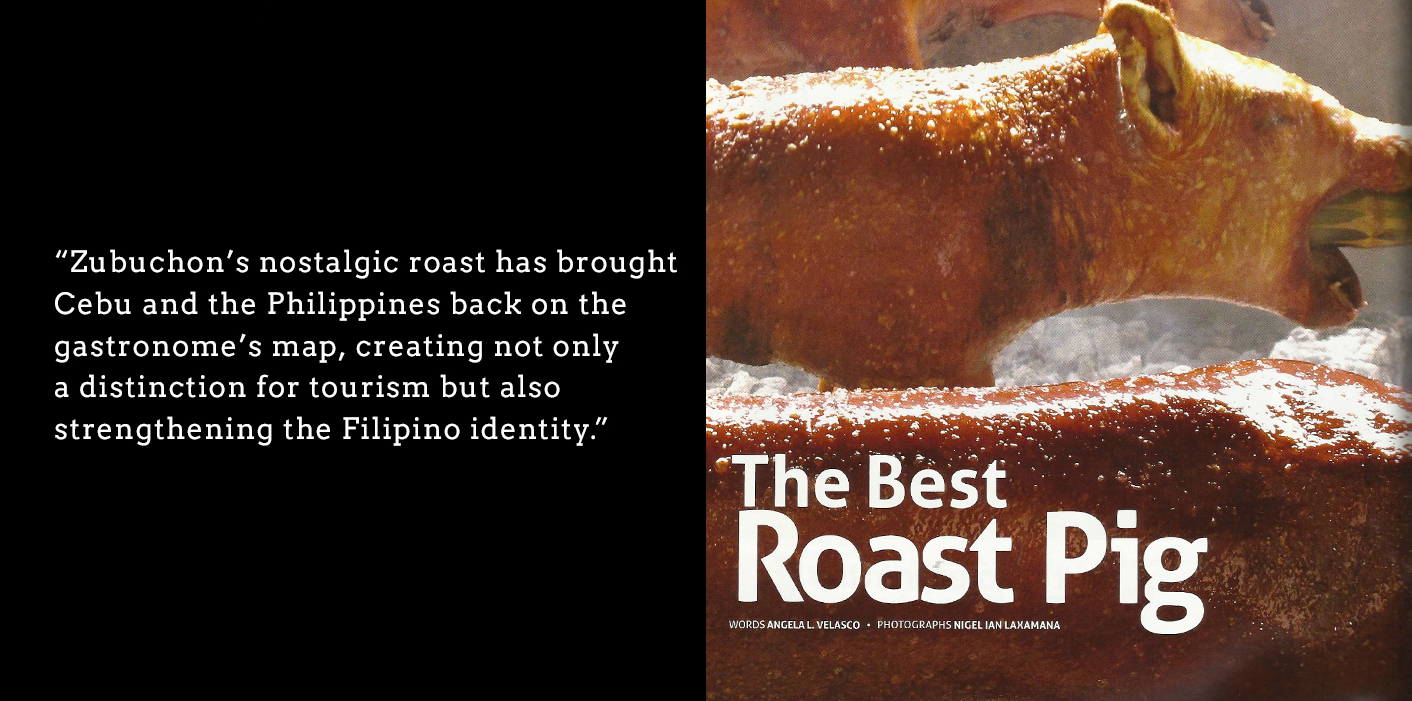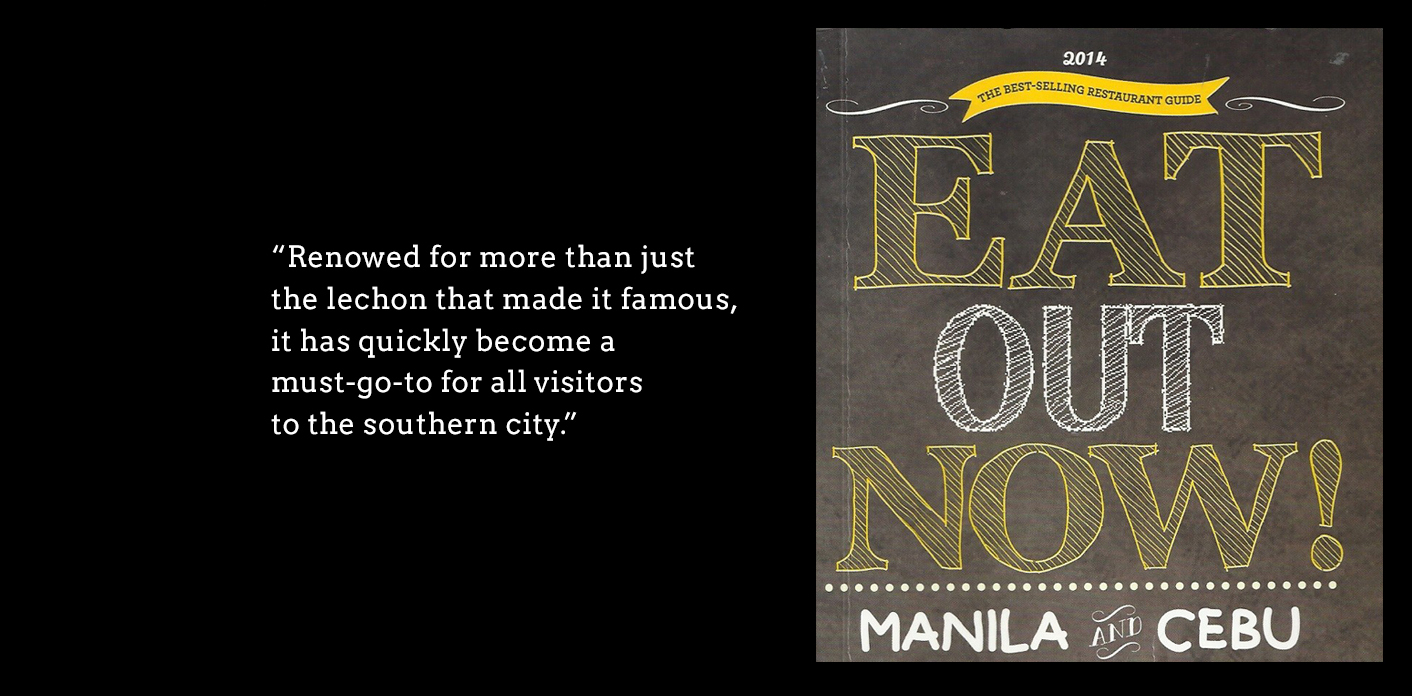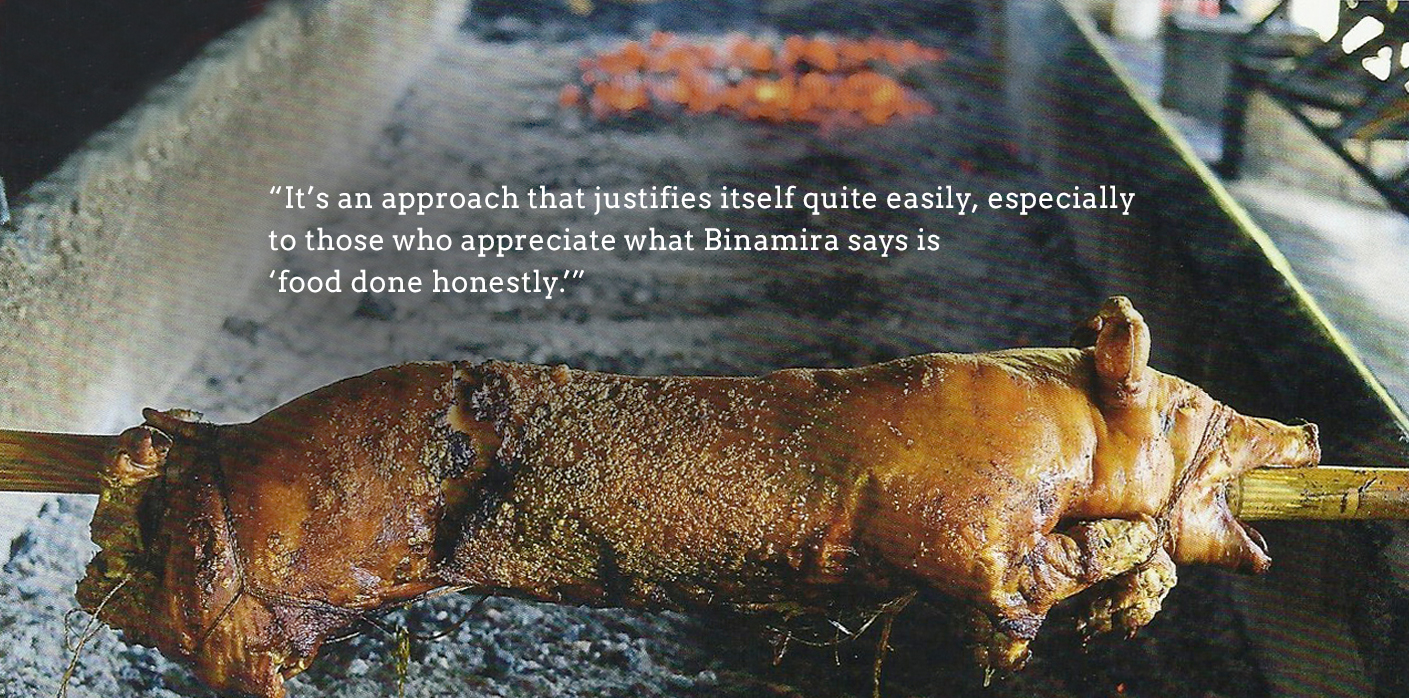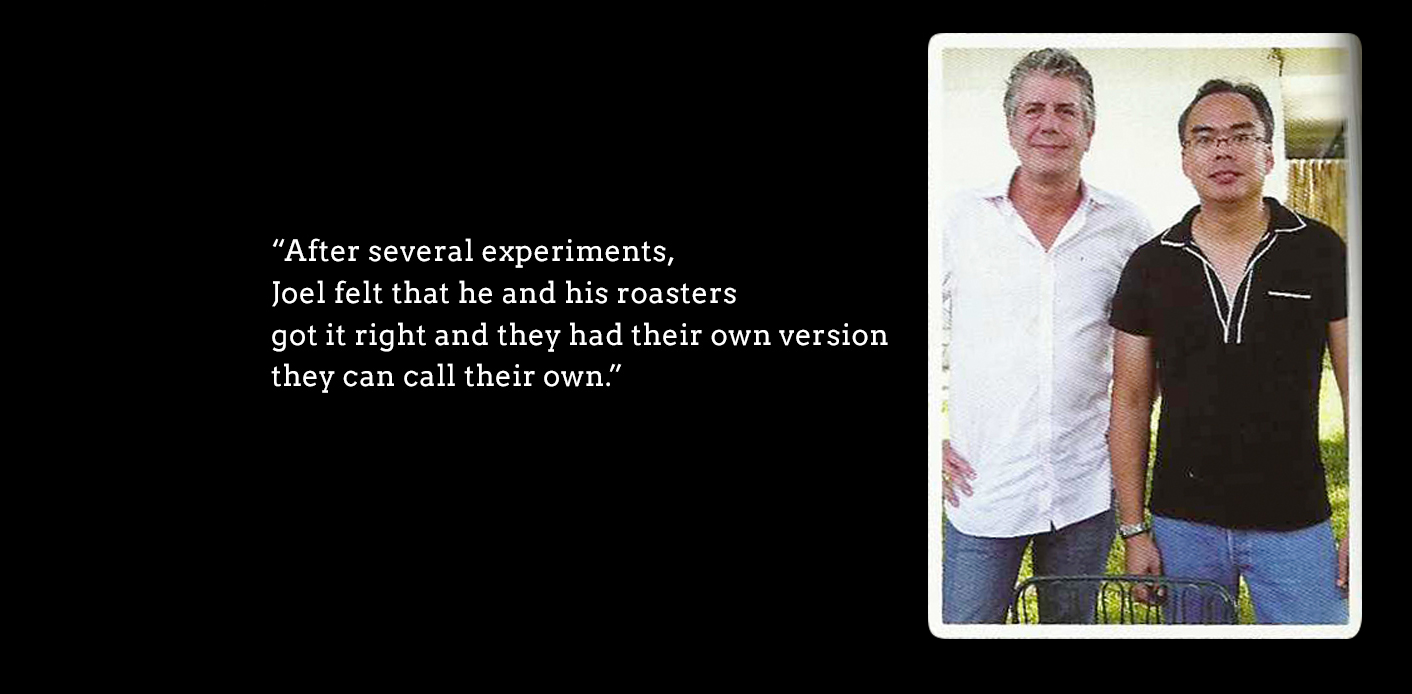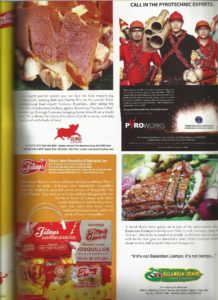THE CEBU LECHON (ROASTED PIG)
THAT ANTHONY BOURDAIN RATED AS THE BEST
From Mabuhay Magazine 2011
This food success story started with an experience in trying to roast pig, know as lechon on the Philippines, the good, old-fashioned way. The man involved in this search is Joel Binamira, an amateur home cook who maintains a respected food blog, www.marketmanila.com and is known as “Marketman.” The old way means using pigs homegrown from the backyard, stuffed with natural ingredients like organic lemongrass without using MSG or any artificial enhancers, slowly roasted on a bamboo pole, and occassionaly acupunctured to produce a crisp skin. After several experiments, Joel felt that he and his roasters got it right and they had their own version they can call their own.
Perhaps due to the popularity of his blog, the crew of Anthony Bourdain contacted him if he can prepare a meal with his lechon as the centerpiece meal for his TV show No Reservations. On camera, Bourdain described eating the lechon skin as “tastes like candy.” After the shoot, Joel asked Bourdain to autograph his book and he wrote “Best Pig… Ever!” With such a powerful endorsement from Bourdain, success was there for the taking. Prodded by his employees, Joel started selling only two lechons on a Sunday. They were sold in 10 minutes. The following Sunday, they increased it to five. 100 people turned up and in 30 minutes, all five were gone.
Now, Joel has two outlets in Cebu named ZUBUCHON-one at One Mango Avenue Building along Maxilom Avenue; and the other is at the Escario Building on Escario Street. There’s also a takeout outlet at the pre-departure area of the Mactan Domestic Airport. For private functions, Joel has opened his sprawling property near the Cebu Provincial Capitol Building.
5 REASONS WY WE CAN’T WAIT TO GO OUT OF TOWN
From Town & Country 2011
Marketmanila.com has been a daily habit for us long before Facebook took over our screen. Having read each and every one of the 3,000+ clever posts since 2005, we are definitely ardent “marketfans”. So when Joel Binamira, a.k.a. Marketman, finally opened Zubuchon in Cebu, we couldn’t help but share his pride and optimism, for if anyone could make the “Best Pig Ever” fly, it would be Joel.
With two Zubuchon restaurants, one gorgeous outdoor dining space for private events, and a take-out counter at the domestic departure lounge at the Mactan Airport, could a Manila location be in the works? Marketman’s not letting on, so in the meantime make your way to Cebu and enjoy your dose of the lechon that made Philippine roasted pig famous. Also offered is a full menu of them using lechon as a base ingredient, while others are meant to complement the richness of the roasted pig.
GRACIOUS LIVING LOVES:
THE SUNDAY LIFESTYLE MARKET
From Gracious Living 2010
Diehard foodies know that Anthony Bourdain pronounce lechon as “the best pig ever” in the Philippines segment of No Reservations. That was a Cebu lechon created by blogger Marketman and for months, many asked and never got the Bourdain lechon. That is, until now. It is finally available on Sundays and beginning December 6, everyday at BTC and the domestic terminal of the Mactan International Airport. Cracked skin and luscious flesh flavored with lemongrass, rosemary, oranges and herbs.
BEST PIG: THE PHILIPPINES
PORK ART
By Lara Day
When itinerant TV chef Anthony Bourdain-whose love of all things porcine is famous-visited the Philippine island of Cebu with his show No Reservations and declared that he had found the “best pig ever”, many viewers were as surprised by the hyperbole as by the country he situated it in. But not Filipinos, among whom the zenith of porky perfection is an indisputable fact. It was just a matter of time before the rest of the world found out.
The pig that made Bourdain smack his lips with glee was lechon, or slow-roasted suckling pig, perhaps the Philippines’ most beloved dish. Usually reserved for fiestas, it has long been a source of fanatical adulation; it’s not uncommon for a whole lechon, still hot and fresh from roasting, to be flown across the country for special occations. Though varieties differ regionally-stuffing can include any combination of lemongrass, tamarind, star anise, garlic, green onions and chili leaves, while condiments range from a light vinegary dipping sauce to a thick liver-based gravy-the basic concept remains the same. A pig is roasted for hours over a fire of open coals, slowly rotated on a bamboo spit, lovingly basted and meticulously supervised until its flesh is so tender, moist and succulent that it can be sliced with the edge of a plate, and its skin so crisp it can be puntured with the tap of a finger. You could call it the Platonic ideal of a pig, but it’s doubtful if Plato, or even an entire faculty of philosophers, could have imagined anything so exquisite.
NOW THIS IS PIGGIN’ OUT: GO BENEATH
THE CRISPY SKIN OF OUR FAVORITE ROAST
By Angelo Comsti
Of everything Anthony Bourdain got to try during his short stint here in the country-from Pampanga’s classics to Binondo’s streetfood-it’s perhaps the lechon that left an imprint in his travelling taste buds.
It made such an impression that it even got him to write about it in his blog early this year (“Heirarchy of Pork” in www.travelchannel.com). Then, not long after declaring out once lowly lechon to be the “best pig ever” the itinerant TV chef has ever sunk his teeth on (besting Indonesia’s and Puerto Rico’s, his runners-up), Time Magazine Asia soon took notice and included it in its Annual Best of Asia list. Many other-from blogs and radio stations to periodicals and TV shows-then followed suit and gave our roasted pig its fifteen minutes. It could have very well been the unproclaimed national dish adobo that made waves in the food scene, but thanks to Marketman and his lechon, much attention was given to that damn delicious beast.
Bourdain may have narrowed it down to the country, but this writer wants to zero in on the city. And given the wide variety of roasted pigs available in the market, it was but wise to ask the “ambassador of lechon” what qualifies as the best one. “As far as regular lechons go, they seem to taste better to me in the provinces”, the well-recognized , yet anonymous blogger confesses. His family is from Cebu and thus explains the reason why he may be partial to the Visayan version of the roasted pig-its stomach cavity stuffed with tons of lemongrass and a mix of seasonings. To achieve that glossy bronze color young Caucasian ladies can only dream of, locals sometimes baste the skin with coconut juice to achieve that perfect marriage of fat, caramelized sugars, and salt all in a single bite. “It should have no MSG, which truly mars the overall experience for me”, adds Marketman as he lists down what makes for a truly good lechon. “It should be done the traditional way, using kawayan and not a mechanized-turning machine: should be eaten within 30 minutes of coming off the flame; and should be as organic as possible.” As this writer realizes, a lot goes into producing a whole roasted pig and consequently, in picking which is the best.
THE BEST ROASTED PIG
By Angela L. Velasco
Crispy, succulent skin that easily break off the tender roasted mat and savory, smoked pork that can be tasted at whiff of its scent. Whether you’re baking chopped pork spices in the oven or roasting the latest kill over charcoal, the draw of roasted meat has captured the world since the domestications of the pig. The Philippines, ever resourceful and open to whatever we can eat, has been feasting on its own variant of roaster pork, lechon, even before the arrival of the Spaniards. Antonio Pigafetta, the Italian scholar who accompanied Ferdinand Magellan upon circumnavigating the world, described in his journals that the locals made a sacrifice of the black pigs “and then roasted them after.”
Lechon is more familiar to foreigners and English speakers as suckling pig. Swine was one of the first animals domesticated for human consumption, with the Egyptian, Sumerian, and Roman cultures known to breed them for this purpose. Even during the earlier days of the Roman empire, the elite would feast on the suckling pig and cook it with herbs such as rue, celery, wine, pepper, and coriander seed. This practice carried on to the Middle Ages, with the pig served during weddings. This tradition is kept alive by other countries such as China, where in the suckling pig is an observed custom that represents the bride’s purity. The Pacific Islands even require the roast pig as a part of a community or family celebration. Various provinces have attempted to outdo each other in giving its locals and visitors “the best lechon delicacy.” From the rows of roasted pigs displayed at the Parada ng Lechon in Balayan, Batangas, the vinegar-dipped pork of Leyte, to the many suppliers competing for the title in Metro Manila, nothing still compared to the “no sauce needed” roast of Cebu.
The pig thrives in an environment that has preserved the Queen of the South’s diverse heritage. From centuries-old churches such as the Basilica Minore del Sto. Nino, the country’s smallest military defense structure, the Fort San Pedro, to old houses such as the Yap-Sandiego Ancestral Home and Casa Gorrodo Museum, whose families lived since the 17th century, the country’s turbulent can be revisited in these structures. Prior to the Spanish occupation, Cebu City’s harbor had a reputation among China, Malaysia, Indonesia, and Thailand for being an active trading center. Ceramics, gold, and other luxurious materials were traded among the nations and have been retrieved from deep seas of Bantayan and other nearby islands. One of the oldest districts in Cebu, the Parian dates back to the 16th century as well. Concepcion Briones reminisces about the more romantic time of this area in Life in the Old Parian. As the venue for Chinese traders converge, it eventually became the home of important Cebuano entrepreneurs and residence of affluent families during the start of the 20th century.
Throughout these cultural and structural changes, the roast pork remained a staple. And because of the pork that both local and foreign tourists flock to, the real star of Cebu is its food. One Manila girl who stayed there for less than a year shared that “dining out choices are few since the Cebuanos are very particular about their food and expenses.” You have to serve exceptionally made cuisines to catch the locals’ attention. Given such a delicious standard, we decided it would be best to narrow down our visit to the search for the Anthony Bourdain, No Reservations host, claimed as the “Best Pig Ever.”
In the episode that catapulted Joel’s roast and the country to gastronomic fame, Anthony Bourdain challenged the country to this title: “that there are few things I love more than pigs roasted over an open pit,” he says leading into the scenes of roasting the pig. “It has been claimed many times that Filipino lechon or whold roasted piggy is the best in the world. I’ve had a lot of good pigs, so that’s a tall order.” But as the episode goes on, Bourdain describes the eating experience with sensual and magnificent words: “Look at this magical animal. The skin’s extraordinary, it tastes like candy.”
Joel Binamira, the man behind the blog Market Manila (marketmanila.com), is responsible for the lechon that caught Bourdain’s attention. Hig blog recorded his various roasting adventures and then suddenly a network called to request that they come and visit. “We were asked by chance to be feaures by Mr. Bourdain and when we did if for him, we told him specifically that it was a private affair.” His blog is also a popular source for cooking and food enthusiasts, his adventures include scouring the capital city and other provinces for local produce and specialty items from market vendors, farmers, and retailers that “seek out the best the Philippines has to offer,’ as described in his About page.
The success of Joel’s roast draws from his determination to achieve and provide a good meal. His experiment began with the building of a “lechonan” that houses the charcoal for pig roasting. He tapped the expertise of professional lechon roasters to ensure that he got the entire process right. He then went through five experiments of incorporating local ingredients until his and the staff’s taste buds were satisfied. Even the pig’s skin went through Joel’s own version of acupuncture. What Bourdain referred to as “the best pig ever” was the perfection of these experiments. Instead of gallons of MSG, a four-hour long slow rendering of lard from the pig’s stomach is what flavors the roast. “There are no tricks,” Joel explains. “We just do it the old-fashioned way.” His historical references include Antonio Pigafetta and food columnist, critic and author Doreen Fernandez.
Apart from the freshness of the ingredients and the careful methodology, Zubuchon aims to uphold high quality with the food served. When we had scheduled our visit to the restaurant, General Manager Joan Danao told us to come at a specific time to ensure that the pig we would have was taken off the charcoal. The pigs are roasted early in the morning and then sent off to the different branches late in the morning. Each batch is made within the day and on each day. “What we want to provide is good tasting food at any location.” Zubuchon’s food is about returning to the delicate and slow processed that result in distinguishable tastes and textures. The lechon redefines this honest form of cooking in particular. There is no need to gnaw through the meat; the pig’s meat meshes into the mouth, allowing the pig’s natural juices to settle on the tongue.
Ironically, some Cebuanos feel that Joel’s roast is not the authentic version. “This is probably cause we throw in rosemary and thyme, tow ingredients that aren’t normally there. Also, the skin isn’t smooth and we don’t paint with soy sauce. Instead, we brush it with coconut water, a practice done 30 of 40 years ago. The coconut water provides a sweetness that can be compared to the 7Up brushed on barbecue,” he elaborates. “We make it a point to really undestand how the food is made, without taking any shortcuts.” Perhaps, apart from its distinguishable taste, it is this honest return to fresh ingredients and the delicacy of the process that make the roast stand out from the rest of the country’s versions. It may not be what some Cebuanos grew up with, but it does bring back practices of our history that today’s Filipinos may not be aware of. Joel’s “best pig ever” has placed Philippine cuisine on a friendlier plate to foreign tongues. “A lot of foreigners are visiting us,” Joel says. “Most of them see Filipino food as something difficult to grasp in such a short period of time. But we’re finding that the roast pig is an easy introduction since they have an idea of roast meat.”
But Zubuchon’s nostalgic roast has brought Cebu and the Philippines back on the gastronome’s map, creating not only a distinction for tourism but also for strengthening the Filipino identity. At the same time, foreigners will also have no problem easing into the best pig ever, as the waiters over the Zubuchon are knowledgeable, and suggest either the “purely Filipino” pairing with rice or the more Western combination of salad. And although every Cebuano suggests you let the lechon taste for itself , a plate of vinegar is served for those who want the pork to have that added kick. However you decide to sample Cebu’s artery-clogging delight, Zubuchon has retracted history’s approach, along with other ingredients that have their home in our islands.
EAT OUT NOW! MANILA AND CEBU
180 RESTAURANTS WE LOVE
by Alicia Colby Sy
What started with Anthony Bourdain’s “best pig ever” has morphed into something ever better, and we dare say that this eatery is on its way to becoming a Cebuano institution. Renowned for much more than just the lechon that made it famous, it has quickly become a must-go-to for all visitors to the southern city.
Althoug without a doubt the pig reigns supreme here, its menu offers more of the best non-porcine Filipino fare. Be sure to drop by its Mactan-Cebu airport location for a bowl of mami and take home some frozen Zubuchon, sisig, and a bag of chicharon for good measure.
*TIP JAR
RECOMMENDED DISHES: Zubuchon, sizzling squid stuffed with sisig, sisig, zubuchorizo, dinuguan, crab relleno, tomato, salted duck egg, bangus tinapa, chili shrimp and chorizo, and ginataang langka.
INSIDE ORDER: A plate of saguyon to start, a bowl of monggo topped with Zubuchon, and budbud kabog.
X-FACTOR: High quality Filipino fare at sharp price points and stylish but straighforward interiors.
SUGGESTED PAIRING: The kamias shake is the best!
ZUBUCHON: CEBU’S ARTISANAL LECHON
by Nikka Corsino
As far as Pinoy food culture is concerned, lechon needs no introduction. But when somebody deviates and comes up with something that interestingly tastes just good – if not better – then everyone is bound to pay attention.
In the case of Cebuano and food lover Joel Binamira, it wasn’t just any other reader on his food blog, www.marketmanila.com, where he documented his personal lechon experiments: it was food connoisseur and chef Anthony Bourdain, who called Binamira after reading his blog’s “Lechon Chronicles” section and asked him to cook lechon for a Philippine episode of the show No Reservations.
By this time, Binamira has already names his own version the Accuchon a la Market-man, which had crisp, chicharon-like skin, a deviation from the traditional smooth, shiny skin of Pinoy lechon.This is achieved by pin-pricking the pig before roasting, which gives it the look of pork cracking when cooked. Binamira came up with this version after a series of experiments in his house in Cebu City, where he would purchase backyard-raised pigs and hire lechoneros weekly.
Apart from the skin, there is another that sets Binamira’s version apart from the others: “I would like to do lechon without MSG”, he says matter-of-factly. Instead, the pigs are generously stuffed with natural herbs and spices such as thyme, rosemary, lemon, and lemongrass.
And as far as Bourdain was concerned, Binamira had served him the “best pig…ever.”
From Accuchon a la Marketman to Zubuchon
“This was never intended as a commercial venture”, Binamira says, recalling how he had to reiterate to people that his lechon wasn’t commercially availableafter demands soared following the airing of the No Reservations episode. Although he arguably knows his food, Binamira points out that his professional background has always been in finance, and that he cooks simply for the love of it.
But “[it] was a time when we were selling properties, and I promised my staff that no one will leave their jobs”, Binamira says when asked how the idea to make the lechon available came up.
“From there, it just grew on its own”, he says.
After a year and a half, Binamira opened Zubuchon’s first branch at Mango Ave. in Cebu City. Zubuchon currently has seven branches in Cebu City and Mactan, all coming in clean, bright, and modern interiors-a novel concept as fas as traditional Cebu lechon houses are concerned.
According to Binamira, Zubuchon aims to serve what he feels is an underserved portion of the market; those who want to eat lechon, but not in the usual per-kilo portions. This explains its restaurant setup, where diner literlly have a place to comfortably sit down and eat their lechon.
But Zubuchon is serving not just the pin-pricked lechon to its patrons, which are a balance of tourists and locals. Also on offer are traditional home-cooked meals with lechon infused in them, including among others: mongo with lechon-which I find very rich and tasty; squid stuffed with lechon sisig; dinuguan done with pork belly and lechon sans the innards-another outstanding iteration of a traditional Pinoy dish; as well as slow-cooked adobo, cooked in clay pots over coal. I am also partial to their artisanal biko, which, in the many times it was served on visits several months apart, was consistently divine.
In offering these dishes, Binamira says they procure their ingredients directly from local-and often small-suppliers in Cebu. This includes the milk that goes into their leche flan, which comes from a small cooperative in Cebu’s highlands. The kamias in their Kamias Shake-which provides a refreshing contrast to the fat of the lechon-is sourced from local homes.
“Anyone who has more than two kamias trees in their backyard here in Cebu knows us”, he says.
“Is it more cumbersome and expensive? Yes. Does it make me feel better? Yes”, he adds, referring to the company’s decision to stick to local, fresh produce for their food. This also effectively puts them at a higher price point than most lechon houses in Cebu, but it’s an approach that justifies itself quite easily, especially to those who appreciate what Binamira says is “food done honestly”.
ALL PIGS GO TO HEAVEN
From Mabuhay Magazine 2012
Certainly so, if all roast pigs taste as good as Zubuchon lechon. Hailed by world-renowned TV host and chef Anthony Bourdain as “the best pig…ever”, the Zubuchon has a crisp skin and tender meat that’s evenly flavored with earthly spices. The secret lies in the way it’s cooked: homegrown pigs are stuffed with all-natural herbs and spices then slowly (no shortcuts here) roasted on bamboo poles over charcoal.
Zubuchon is flavored with more than 12 herbs and spices. Its skin is punctured all over and sprayed with coconut water, resulting in crispy, brown skin.




